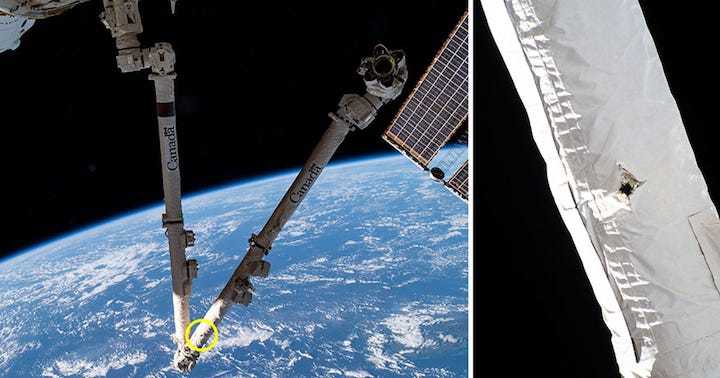3.06.2021

A piece of space debris recently struck the Canadarm2 on the International Space Station leaving a small hole. The Canadian Space Agency is calling it a “lucky strike” because the robotic arm is still functioning.
“Seriously, this shows the threat of orbital debris as much as robust Canadarm2 engineering with 20 years of intense Space Station operations,” tweeted Gilles Leclerc, Director General of the Canadian Space Agency after the agency announced the strike on May 28.
CSA did not mention whether the debris was natural or manmade.
Canada’s iconic robotic arm, Canadarm, was used on the space shuttle to deploy, maneuver and capture payloads. The second generation Canadarm2 went into service in 2001 on the space station. It is longer and more advanced and serves many functions including moving supplies and even astronauts.
During a routine inspection on May 12 robotic operators observed the hole in the boom section of the Canadarm2. After working with NASA to take detailed images of the impact, the agencies concluded the hole is about 5mm in diameter.
The damage is limited to a small section of the arm boom and thermal blanket. CSA says despite the impact, the arm’s performance is unaffected.
In fact, the Canadarm2 is in the middle of a big job positioning its “robotic hand,” called Dextre, in order to replace a faulty power switchbox.
CSA said the “threat of collisions is taken very seriously.”
Over 23,000 objects the size of a softball or larger are tracked 24/7 to detect potential collisions with satellites and the space station. A number of tinier objects — ranging from rock or dust particles to flecks of paint from satellites — are too small to be monitored.
With more stuff going to space, there’s also more trash in space — nearly 6,000 tons — and the likelihood of impacts are increasing.
NASA says low-Earth orbit is a space junk yard filled with millions of pieces of rockets, spacecraft and satellites flying at speeds up to 18,000 miles per hour.
All that junk orbiting Earth poses a significant safety risk to people and property in space and on Earth.
In 2020 the International Space Station had to redirect three times to avoid space debris. Prior to that, the last time a move was necessary was in 2015. This year there have been a couple of close calls before the collision in May.
Quelle: Florida Today
